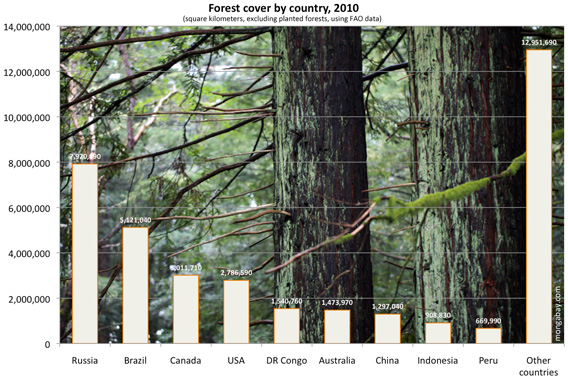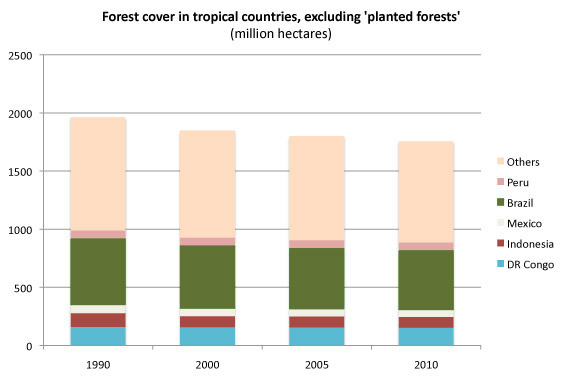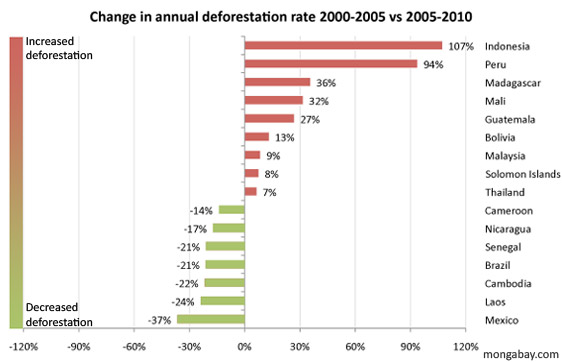
Global forest cover by country. Background: redwood forest in Woodside, California
Forests are a key part toward the shift toward a “greener” economy said a cadre of U.N. officials as the body officially launched its International Year of Forests to highlight the global importance of forests.
“Every one of us, all seven billion people on earth, has our physical, economic and spiritual health tied to the health of our forest ecosystems,” said Jan McAlpine, the Director of the U.N. Forum on Forests, in a statement.
“[Forests] are also cornerstones of our economies, whose real value has all too often been invisible in national accounts of profit and loss,” added Achim Steiner, Executive Director of the U.N. Environment Program.
To mark the beginning of the International Year of Forests, the U.N. Food and Agriculture Organization (FAO) released The State of the World’s Forests (SOFO), a report that comes out every two years and assesses the status of global forest resources.
SOFO 2011 includes information on trends in forest management, production of forest products, and raw forest cover data. The report notes that the forestry sector is working to reduce its impact on the environment through better forest management and improved energy efficiency in production of forest products.
The International Year of Forests comes at what could represent a transition point for forests. Deforestation rates are slowing and policy-makers are showing unprecedented interest in protecting forests as a climate change mitigation strategy known as REDD (Reducing Emissions from Deforestation and Degradation). Some governments have enacted laws restricting trade in illegally logged timber, while retailers are showing new concern on the origin of forest products.
But risks to forests remain. Rising demand for food, fiber, and fuel will put pressure on remaining forest lands while climate change could increase the vulnerability of some forests to drought, fire, and disease outbreaks. Poor design, insufficient governance, and entrenched interests in the forestry sector intent on maintaining the status quo could undermine the REDD mechanism, hurting a key potential source of funding for forest protection and management.

Global Forests
According to FAO data released last year, forests presently cover around 31 percent of global land area, or nearly 4 billion hectares.
FAO figures show deforestation across 121 tropical countries averaged 9.34 million hectares per year between 2000 and 2010, down from 11.33 million hectares per year in the 1990s. The decline has accelerated since 2005 due Brazil’s dramatic reduction of deforestation in the Brazilian Amazon, which peaked at 27,772 square kilometers in 2004 but is expected to come in at less than 8,000 for 2010. Overall Brazil’s reduction in deforestation since 2005—which fell from 3.2 million hectares per year from 2000-2005 to 2.5 million hectares in 2005-2010—more than offset increases in forest clearing in other major forest countries including Indonesia (107 percent increase), Peru (94 percent), and Madagascar (36 percent) during the period.
FAO estimates global deforestation fell from 16 million hectares per year in the 1990s to 13 million hectares per year in the past decade. Factoring in planted forests, the rate of forest loss fell from 8.3 million hectares per year to 5.2 million hectares, an area about the size of Costa Rica.
Primary forest, the most carbon-dense and biologically diverse form of forest, declined by more than 40 million hectares over the past decade, primarily a result of first-time logging.

Related articles
Loss of old growth forest continues

(10/06/2010) A new global assessment of forest stocks by the U.N. Food and Agriculture Organization (FAO) shows continuing loss of primary forests since 2005 despite gains in the extent of protected areas. FAO’s Global Forest Resources Assessment 2010 reveals some 13 million hectares of forest were cleared between 2000 and 2010, down from around 16 million hectares per year during the 1990s. Loss of primary forest—mostly a consequence of logging—averaged 4.2 million hectares per year, down from 4.7 million hectares per year in the 1990s.

(03/25/2010) Global forest loss has diminished since the 1990s but still remains “alarmingly high”, according to a preliminary version of a new assessment from the U.N. Food and Agriculture Organization (FAO). The report, Global Forest Resources Assessment 2010 (FRA 2010), shows that global forest loss slowed to around 13 million hectares per year during the 2000s, down from about 16 million hectares per year in the 1990s. It finds that net deforestation declined from about 8.3 million hectares per year in the 1990s to about 5.2 million hectares per year in the 2000s, a result of large-scale reforestation and afforestation projects, as well as natural forest recovery in some countries and slowing deforestation in the Amazon.
Commodity trade and urbanization, rather than rural poverty, drive deforestation

(02/07/2010) Deforestation is increasingly correlated to urban population growth and trade rather than rural poverty, suggesting that measures proposed to reduce deforestation will be ineffective if they fail to address demand for commodities produced on forest lands, argues a new paper published in Nature GeoScience.
Rainforest conservation: a year in review
(12/27/2009) 2009 may prove to be an important turning point for tropical forests. Lead by Brazil, which had the lowest extent of deforestation since at least the 1980s, global forest loss likely declined to its lowest level in more than a decade. Critical to the fall in deforestation was the global financial crisis, which dried up credit for forest-destroying activities and contributed to a crash in commodity prices, an underlying driver of deforestation.
Changing drivers of deforestation provide new opportunities for conservation

(12/09/2009) Tropical deforestation claimed roughly 13 million hectares of forest per year during the first half of this decade, about the same rate of loss as the 1990s. But while the overall numbers have remained relatively constant, they mask a transition of great significance: a shift from poverty-driven to industry-driven deforestation and geographic consolidation of where deforestation occurs. These changes have important implications for efforts to protect the world’s remaining tropical forests in that environmental lobby groups now have identifiable targets that may be more responsive to pressure on environmental concerns than tens of millions of impoverished rural farmers. In other words, activists have more leverage than ever to impact corporate behavior as it relates to deforestation.
Destruction of old-growth forests looms over climate talks

(12/08/2009) Destruction of old-growth or primary forests looms large in discussions in Copenhagen over a scheme to compensate tropical countries for reducing emissions from deforestation and degradation (REDD). Some environmental groups are pressing for conservation of old-growth forests — the most carbon-dense, and biologically-rich state of forests — to be the centerpiece of REDD, while industry and other actors are pushing for “sustainable forest management” or logging using reduced-impact techniques to be the primary focus of REDD.

(07/22/2009) Until now saving rainforests seemed like an impossible mission. But the world is now warming to the idea that a proposed solution to help address climate change could offer a new way to unlock the value of forest without cutting it down.Deep in the Brazilian Amazon, members of the Surui tribe are developing a scheme that will reward them for protecting their rainforest home from encroachment by ranchers and illegal loggers. The project, initiated by the Surui themselves, will bring jobs as park guards and deliver health clinics, computers, and schools that will help youths retain traditional knowledge and cultural ties to the forest. Surprisingly, the states of California, Wisconsin and Illinois may finance the endeavor as part of their climate change mitigation programs.